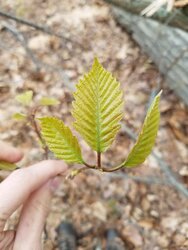The trees are leaving these nice green identification tags on them now. It's kind of nice.
Sometimes it can be still hard to tell. Unfortunately I didn't grab more pictures but this one has deeply furroughed bark, alternate branches, and plain oak looking wood. Otherwise I think it looks like sassafrass/Black walnut/BL type bark. It is also surrounded by a bunch of oaks/beech.
Attached pic of the juvenile leaves. Any guesses? Swamp white oak or chestnut oak?
Thanks.
Sometimes it can be still hard to tell. Unfortunately I didn't grab more pictures but this one has deeply furroughed bark, alternate branches, and plain oak looking wood. Otherwise I think it looks like sassafrass/Black walnut/BL type bark. It is also surrounded by a bunch of oaks/beech.
Attached pic of the juvenile leaves. Any guesses? Swamp white oak or chestnut oak?
Thanks.



 .
.